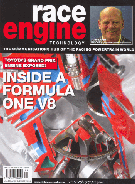- Race Engine Technology -
SPECIAL REPORTS: NASCAR Cup, Formula One, 24-Hour Racing, Drag Racing
NOTE: All our Products, Designs, and Services are ORGANIC, GLUTEN-FREE, CONTAIN NO GMO's, and will not upset anyone's precious FEELINGS or delicate SENSIBILITIES.
NOTE: THE REPORTS DESCRIBED HERE ARE PUBLISHED BY HIGH POWER MEDIA INC.
TO PURCHASE COPIES, CLICK HERE.
Here are Quick-Links directly to the various different areas of racing
covered in these Special Reports.
NASCAR CUP FORMULA ONE 24-HOUR RALLY DRAG RACING
These CUP RACING Special Reports provide an unparalleled look into the engineering and development that makes it possible for these 3400-pound, 860 HP, small-tired NASCAR CUP cars to achieve speeds in excess of 200 mph in tight quartered racing, as well as an understanding of the rules, tweaks, insights and traditions that provide the incomparably close racing that allows a blanket to be thrown over the front 10 cars at the finish of a 500 mile event.
SPECIAL 2013 REPORT: NASCAR CUP Race Technology, Volume 4
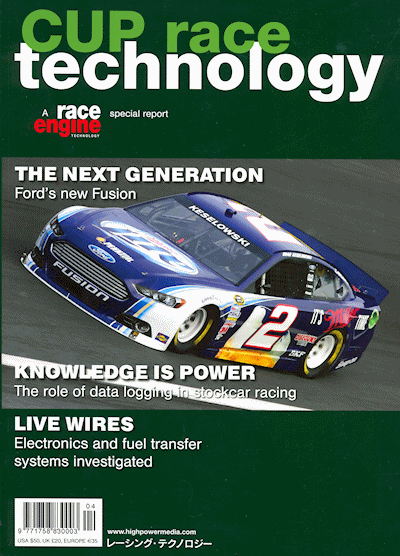
CUP Race Technology, Volume 4
(click for larger image)
Published in March, 2013, this informative issue discusses NASCAR the sweeping changes incorporated in the Gen-6 body style and associated chassis upgrades, electronic refinements and improvements that have evolved from the first year of EFI usage, and lots more.
FEATURES:
1. GRID - An inside look at the more-than-skin-deep regulation changes for 2013; A look at the use of six-degree-of-freedom race simulators for driver refinement and for testing chassis setup; A chat with John Darby (NASCAR managing director of competition) about the transition to the Gen-6 car, and more.
2. INTERVIEW: McLaren and NASCAR....The First Year - Lawrence Butcher talks in depth with Peter van Manen, managing director at McLaren Electronics, supplier of the ECU for the Cup cars' EFI systems, discussing interesting topics regarding the introduction of EFI, the challenges, surprises, support, and rule-bending encountered during the first year of EFI in Cup.
3. PROFILE: Roush-Fenway's Nationwide Series Ford Mustang - Lawrence Butcher looks at the relationship between Ford Motor Company and Roush-Fenway Racing, chronicling the development of the Ford Mustang for the Nationwide series, including discussions of aerodynamics, chassis details, suspension, powertrain, and development of the racing platform.
EPI NOTE: please excuse the minor technical error in this article, in which the bore spacing of the FR-9 engine was reported as 4.125 inches. In fact, the bore spacing of the current Cup engines (FR-9, R-07, Toyota, and the {currently not used} Dodge R6P8) is 4.500 inches, and the typical bore-stroke dimensions are 4.185 x 3.250. All these current engines are purpose-built race engines, designed to optimize the provisions of NASCAR's strict and very specific rulebook.. The bore spacing of the predecessor Chevy and Dodge engines was 4.400 inches, and the predecesssor to the FR-9 (the Windsor) was 4.380 inches. When Toyota began racing in NASCAR, they had no pushrod V8 in production, so NASCAR allowed them to develop a clean-sheet V8 for NASCAR. That engine was designed around the 4.500 bore center dimension, with a substantially-raised camshaft centerline and a number of other design advantages. NASCAR incorporated many of the Toyota engine dimensions and features into their engine rulebook, then allowed the other manufacturers to design 2-valve pushrod V8's to take advantage of the same features.
4. INSIGHT: Data Logging - An in-depth look at the extent and methodologies which the Cup teams have developed to compensate for the prohibition against data acquisition under race conditions. This interesting article includes a discussion of gathering of data from various tracks to provide the input database for the racecar chassis and engine simulation activities (see NASCAR engine testing), as well as discussions of sensor technology, parameters measured, and data acquisition capabilities.
5. FOCUS: Electronics -Wiring systems in NASCAR have changed almost beyond recognition in the past couple of years, and the evolving technology is very interesting. This article discusses the system layout, the engine loom, various wiring and insulation materials, connectors, and evolutions in reliability engineering.
6. PROFILE: the 2013 Ford Fusion Cup Car - Lawrence Butcher recounts the development of the new Gen-6 Ford Fusion Sprint Cup car, which combines parity of performance with distinct brand identity, discussing the background of the Gen-6, the early days of the joint development effort, cooperation among the OEM's, dimensions, aerodynamic development, construction and testing.
7. FOCUS: Fuel Supply Systems - NASCAR fuel systems are far more sophisticated than many observers realize. This in-depth article provides a fascinating view into the requirements, technologies and implimentations involved in the current cars' fuel systems.
8. TECHNICAL REVIEW - An Eye to the Future - In spite of the tight regulations, the pace of development in NASCAR is relentless. This article looks at a few new components and technologies being considered for the medium-near term, including the application of nanotechnology to the engineering of fluids designed specifically to optimize performance in a given application (engine lubricants, transmission lubricants, hypoid-gear lubricants, etc), advances in stiffness and strength in braking systems, new structural materials
EPI NOTE: Please forgive the apples-to-oranges photos comparing the crushed-weld performance of 4130 tubing to the high-manganese DOCOL tubing. Even though the photos seem rigged, the bottom line is that the DOCOL does provide post-weld strength similar to 4130, with substantially greater ductility.
SPECIAL 2012 REPORT: NASCAR CUP Race Technology, Volume 3
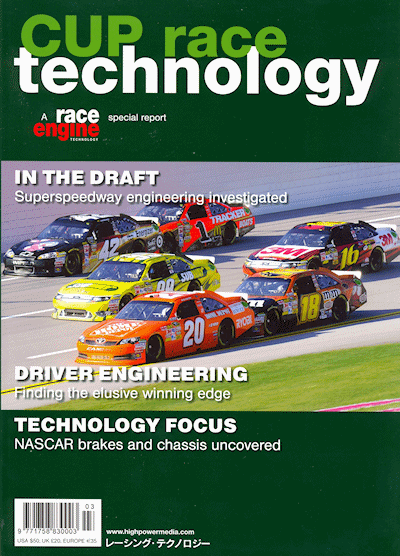
CUP Race Technology, Volume 3
(click for larger image)
FEATURES:
1. GRID - A series of short articles describing some new and interesting developments, including the 2013 Ford Focus (first of the "new breed" of CUP cars), new developments in racing engine oils, and recent changes in the Superspeedway (Daytona and Talladega) rules to reduce the two-car-tandem style of racing.
2. PROFILE: Red Horse Racing - This organization repeatedly holds its own against teams that are part of larger Sprint Cup organizations. This is a look at what it takes to compete at the "economy" level.
3. INSIGHT: Superspeedway Engineering - Dr. H.A. Mergen, one of the most respected Chassis & Simulation engineers in CUP racing (currently with Hendrick Motorports) provides a fascinating in-depth look at the engineering, preparation and testing that goes into fielding a superspeedway championship-contending race car.
4. FOCUS: Corners - Although NASCAR Sprint Cup cars have their origins and roots in the 1960's, their alleged "simplicity" hides an unimaginable wealth of engineering detail in every component of the car. This is especially critical at each of the four corners. Lawrence Butcher reports on this technology.
5. INSIGHT: Fuel Injection - NASCAR has finally bid farewell to the trusty (and VERY evolved) four-barrel carburetor in CUP racing. Wayne Ward reports on the challenges that teams face and the advantages to be realized from the transition to this newer technology.
6. SPECIAL INVESTIGATION: Engineering the Driver - Ronn Langford presents an argument that the racecar driver can be treated as a set of reprogrammable and upgradable systems.
7. FOCUS: Brakes - 500 laps around a 1/2 mile bullring like Martinsville demands the ability to dissipate unimaginable amounts of energy-per-unit-time, decelerating these 3400+ pound cars from well over 110 mph to around 55 mph once every 9 seconds. The brake rotors glow red-hot behind the wheels, and the tire beads melt if the system is abused. Lawrence Butcher reports on the state-of-the-art in these essential braking systems.
8. TECHNICAL REVIEW - The pace of development in NASCAR is relentless. Tiff Daniels looks at the latest technology developments both on and off the track..
SPECIAL 2011 REPORT: NASCAR CUP Race Technology, Volume 2
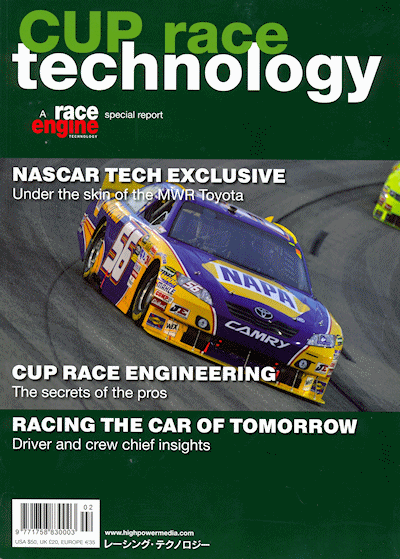
CUP Race Technology, Volume 2
Published in January, 2011, this issue discusses NASCAR COT aerodynamics, chassis engineering, engine technology, driving insights and lots more.
FEATURES:
1. GRID - A series of mini-features describing various critical NASCAR Sprint Cup rules, including a discussion by Dr. Andy Randolph (ECR Engines) of the introduction of fuel injection into NASCAR, the use of CFD in cooling system design, developments in piston technology, and more.
2. FOCUS: NASCAR Engineering Tools - Dr. H.A. Mergen, Chassis & Simulation engineer for Hendrick Motorports, provides a fascinating in-depth look at the chassis engineering and development processes used at NASCAR's upper levels.
3. ANATOMY OF A COT - Ian Bamsey and Martin D. Clark give an entrancing and detailed presentation on the details of a Michael Waltrip Racing COT, including body, frame, suspension, brakes, transmission and more.
4. FOCUS: COT Aerodynamics - Dr. H.A. Mergen provides another fascinating look inside the aero development and testing processes used at NASCAR's highest levels.
5. FOCUS: Engineering The COT V8 - Wayne Ward describes several areas in which the engine developers have found improvements in power and reliability within the tight confines of CUP engine rules..
6. FOCUS: COT Transmission - John Coxon describes the innards of the evolved T-10 gearboxes currently used, with the refinements and sophistications from today's technologies that fit under the NASCAR rulebook.
7. INSIGHT: Driving the COT - A fascinating report based on conversations with some of the top talent in Cup about driving challenges at diverse tracks including Martinsvile, Bristol, Dover, Charlotte, Watkins Glen, Daytona and Talledega. The talent includes Mark Martin and crew-chief, Alan Gustafson, Joey Logano and crew chief Greg Zipadelli, AJ Allmendinger, Juan Pablo Montoya, David Reutimann and Carl Edwards.
SPECIAL 2010 REPORT: NASCAR CUP Race Technology, Volume 1
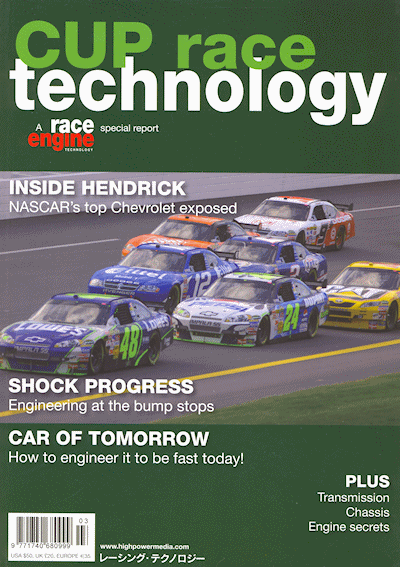
CUP Race Technology, Volume 1
FEATURES:
1. The New Rules - A series of mini-features describing various critical NASCAR Sprint Cup rules, including the "gear rule", aerodynamics, COT setup, and tech inspections.
2. Taming The Impala - Inside Hendrick Motorsports for a detailed look under the skin of the best Chevrolets in NASCAR: Layout, frame, suspension, brakes, engine, transmission, electrics, ancillaries, bodywork, and plan view drawing.
3. Four Corners - The new challenges the COT brings to shocks, brakes and tires, and how suppliers are meeting those challenges.
4. Four on the Floor - Details of how the new COT gearbox evolved from the 1957-vintage T-10, including the CR-1, CR-2 and ST-10.
5. Engineering Solutions - The design and development paths being followed by Toyota to meet the challenges of the COT: layout, aero, downforce, springing, damping, front and rear suspension, brakes.
6. Keeping It Flowing - A discussion of the intricate and demanding plumbing details in the COT: Oil, fuel, cooling,
7. Hidden Gems - Details about various high-tech CUP engine components and the companies which supply those components: pistons, rings, rods, cranks, cams, bearings, valves, springs, coatings, fasteners.
SPECIAL 2012 REPORT: F1 Race Technology, Volume 7
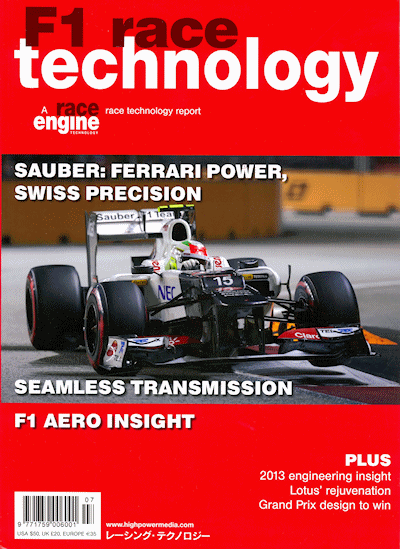
F1 Race Technology, Volume 7
(click for larger image)
PUBLISHED IN JUNE, 2013, this fascinating new issue discusses Sauber, Lotus, Williams, and Force India efforts, as well as the latest in transmission technology and aerodynamics, and lots more.
FEATURES:
1. Intro: EDITOR - Ian Bamsey discusses the "spirit" of the F1 regularions and how teams work to circumvent them.
2. Upfront: GRID - A variety of short articles, including: Why the 2012 grid qualifying times were closer together than ever; A system for monitoring tire temperatures in real time; A look at the sad demise of HRT.
3. Insight: SAUBER C31 - Ian Bamsey discusses the development of the impressive Sauber C31-Ferrari with chief designer Matt Morris and Gianpaolo Dall'Ara, head of track engineering, .
4. Technical Review: 2012 - Ian Bamsey discusses the key technical trends of the past season, including engines, KERS, transmissions, brakees, chassis and aero.
5. Insight: LOTUS E20 - Ian Bamsey quizzes James Allison, the technical director of Lotus F1, about the initial development of the Lotus team's 2012 Grand Prix winning car.
6. Focus: TRANSMISSIONS - Due to its location, the gearbox plays a significant role in the overall aerodynamic performance of the car. As ever, it is the regulations that are driving - and will continue to drive - innovation in transmission systems, as reported by Lawrence Butcher.
7. Insight: WILLIAMS FW34 - Williams was a rejuvenated team in 2012. In mid-season, Ian Bamsey captured chief operations engineer Matt Gillan for some insight into how that came about.
8. Insight: AERODYNAMICS - Lawrence Butcher presents the highlights of a fascinating lecture on F1 aerodynamics, given by Willem Toet, Sauber's head of aerodynamics.
9. Insight: FORCE INDIA VJM05 - Andrew Green, Force India's technical director, explains to Ian Bamsey the team's approach to aero, as embodied by the VJM05 car.
10. Focus: MANUFACTURING - Lawrence Butcher catches up on the latest developments in component manufacturing technologies, covering composites, material joining techniques, high temperature applications, automation and rapid prototyping / manufacturing.
11. Roundup: FORMULA ONE PADDOCK - As the "last Season of the V8's" (2013) was getting underway, Lawrence Butcher talked to a Formula One insider about the novelties of the various teams' latest technologies, including suspension, exhaust systems, and bodywork.
12. Directory: FORMULA ONE SUPPLIERS, 2012 - A current listing of companies offering Formula-One level products and services.
SPECIAL 2012 REPORT: F1 Race Technology, Volume 6
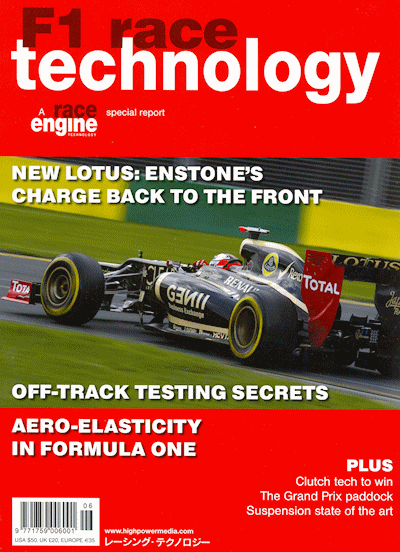
F1 Race Technology, Volume 6
(click for larger image)
FEATURES:
1. Upfront: GRID - An intriguing look at the factors that allowed Red Bull to dominate the 2011 season; the growing importance of KERS; details on the radical new Williams transmission.
2. Insight: FORMULA ONE AERO-2012 - Ian Bamsey confers with an F1 Insider to present a detailed look at the aero developments that provide the 2012 cars with nearly the same downforce as in 2011, despite the regulated loss of some key technology.
3. Insight: LOTUS F1 TEAM - Ian Bamsey discusses the rejuvenation of the Lotus F1 Team with their technical director James Allison.
4. Focus: SUSPENSION & BRAKING - Lawrench Butcher examines the components upon which Formula One cars rely for their unimaginable cornering and stopping performance.
5. Technical Review: 2011 - Ian Bamsey speaks with seven Formula One technical directors to discuss key elements and aspects of the 2011 Formula One technology.
6. Focus: OFF TRACK TESTING - Lawrence Butcher discovers what resources and procedures the Formula One teams currently use to cope with the extensive limitations of on-track testing.
7. Insight: AP RACING CLUTCH DEVELOPMENT - Ian Bamsey discusses the engineering challenges presented by racing clutch development for the current naturally-aspirated 2.4 liter V8, and the recent and evolving solutions to those challenges.
8. Directory: FORMULA ONE TEAMS, 2012 - Lawrence Butcher brings us up to date on the 2012 teams, team changes, and car developments.
9. Directory: FORMULA ONE SUPPLIERS, 2012 - A current listing of companies offering Formula-One level products and services.
SPECIAL 2011 REPORT: F1 Race Technology, Volume 5
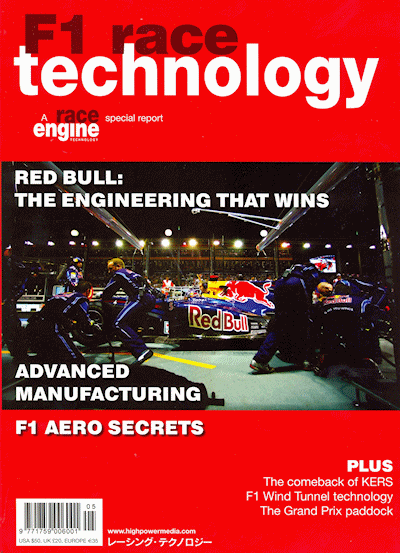
F1 Race Technology, Volume 5
FEATURES:
1. Upfront: GRID - An intriguing look at the rules changes since 2008 in an effort to slow the cars down and how subsequent engineering and refinement has restored the performance despite the rules changes. ALSO, an introduction to the latest aero downforce technology: exhaust augmentation of the diffuser.
2. Insight: BRAKES - A detailed analysis of the latest in technology, improvements and implementations embodied in contemporary F1 braking systems.
3. Special Investigation: 2010 RED BULL-RENAULT - An in-depth look at the features of the RB6 world championship car, including engine developments, aero developments, pullrod suspension, the "F-duct", exhaust augmentation, and more.
4. REVIEW - 2010 - Ian Bamsey discusses key aspects of 2010 technology with six leading technical players.
5. Focus: ADVANCED MANUFACTURING TECHNOLOGIES - Lawrence Butcher presents a very knowledgeable and competent look at the adoption of some state-of-the-art machining and manufacturing processes, materials and prototyping techniques.
6. Insight: TOYOTA'S WIND TUNNEL - A report on the technical innovations that prompted Ferrari to turn to Toyota's F1 wind tunnel in developing its 2011 car, and the technical innovations that provide a dramatic improvement in data acquisition and analysis in view of the FOTA testing restrictions.
7. Focus: SENSORS - A new look at the advances in sensor technology, where new sensors are loacated and what they can accomplish.
8. GRAND PRIX PADDOCK - Lawrence Butcher reports from the GP paddock with a preview of the 2011 technology features and a complete directory of the 2011 F1 teams, players and equipment.
SPECIAL 2010 REPORT: F1 Race Technology, Volume 4
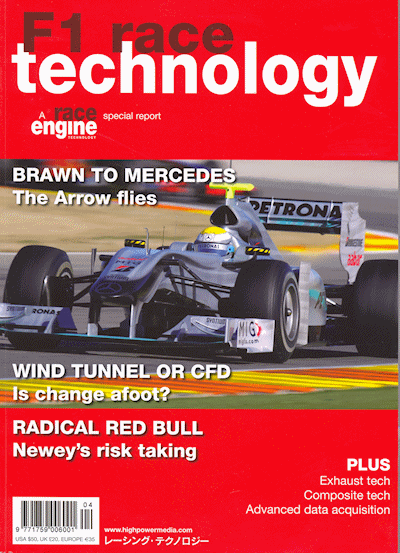
F1 Race Technology, Volume 4
FEATURES:
1. Upfront: GRID - A look at the important changes in technology for the 2010 season, including discussions of the McLaren Wing Stall System, the Double Diffuser, chassis setup differences, the Cosworth / XTRAX F1 gearbox, the implications of the refuelling ban, and the WHP / KERS system.
2. Insight: BRAKES - A detailed analysis of the technology and implementations embodied in contemporary F1 braking systems.
3. State of the Art: EXHAUSTS - A report on the materials, advances, and technologies found in contemporary F1 exhaust systems.
4. Insight: RED BULL - A discussion with CTO Adrian Newey on the rise of the Red Bull team to prominence, with detailed discussions of the RB5 F1 car, aero developments, the budget cap, the switch to slick tires, and more.
5. Insight: WIND TUNNELS - An investigation into the current role of wind tunnel testing in F1, with descriprions of systems designed to replicate reality more fully.
6. Insight: CFD - A report on the current state of the art in Computational Fluid Dynamics as used in F1 chassis design (a very interesting complement to the previous article on wind tunnel testing).
7. Review: 2009 - A review of the challenges met in the 2009 season and how those challenges reflected forward into the 2010 cars.
8. Insight: ADVANCED COMPOSITES - A revealing article on the development and progression of the monocoque chassis to today's advanced carbon-fiber composites.
9. Insight: DATA ACQUISISION - A discussion of the growth, significance, and technology involved in today's race car real time data acquisition systems.
10. F1 PADDOCK - A "who is whom" in the world of F1 teams and technology in 2010.
SPECIAL 2009 REPORT: F1 Race Technology, Volume 3
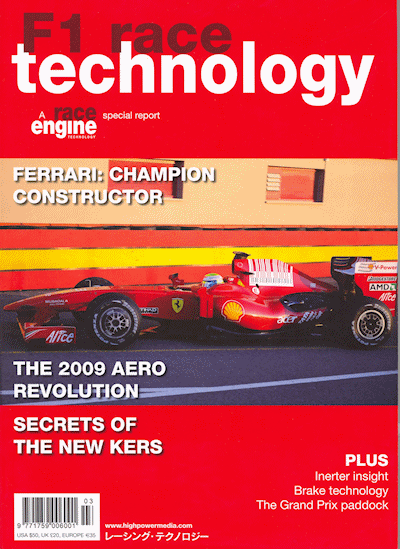
F1 Race Technology, Volume 3
FEATURES:
1. Upfront: GRID - A series of short articles high-lighting key technical issues in this new era of 2009 F1 racing.
2. Upfront: BRAWN GP - The amazing rise of a shop floor machinist who went on to engineer world titles than make his own Grand Prix-winning car.
3. Upfront: FERRARI - An in-depth comparison of the 2008 Constructor's Championship winner to its 2009 successor, designed under very different aerodynamic requirments and restrictions.
4. State of the Art: F1 AERO - A discussion of the implications of the new F1 aerodynamics rules and the impact they have had on performance at the start of this new era.
5. Insight: KERS - An analysis of the electric motor-based KERS system now being used in Formula One cars during acceleration and braking.
6. Insight: ADVANCED METALS - A report on the many and varied types of metals used in Grand Prix cars in the recent past and today under a more restrictive set of rules.
7. The Challenge from the 2008 F1 Season - A review of how Grand Prix cars evolved during the 2008 season under the impact of the SECU, hence without traction controls.
8. Insight: F1 BRAKES - A discussion of the challenge of stopping F1 cars, especially with slick tires and KERS bring significant new issues into the mix.
9. Investigation: BMW's GP WINNER - A look at how Sauber developed its 2008 car well enough to take the team's first-ever win at the Canadian GP in June.
10. Insight: THE INERTER - Suspension technology takes another intriguing twist when McLaren pioneered this Cambridge University invention in F1.
11. The Future: COST CAPPED F1 - A look at the engineering challenges of setting up a new team under the new-for-2010 cost cap of £30 million: Is that sum a realistic one?
12. F1 PADDOCK - A summary of the five engine manufacturers, the ten competing teams, the key people behind them and the new look F1 cars.
SPECIAL 2008 REPORT: F1 Race Technology, Volume 2
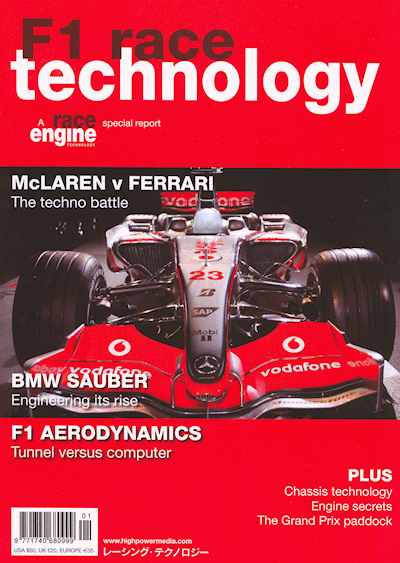
F1 Race Technology, Volume 2
FEATURES:
1. Introduction - A series of mini-features including: (a) A look forward to 2009 F1 technology and the potential impact on the sport; (b) Issues with the floor of the monocoque chassis; (c) Advances in aerodynamics; (d) Effects of the mandated generic ECU; (e) Aero-driven suspension compromises; (f) Brake rotor and caliper developments.
2. The 750 BHP Grand Prix Cars - A detailed discussion of the impact of the 2008 F1 rules: Vehicle Layout, Engine, Clutch, Gearbox, and Control System.
3. Gaining Momentum - An in-depth examination of how BMW-Sauber rose to become the "third force" in the current V8 F1 era; Discussions with BMW's Dr. Mario Theissen and Sauber Technical Director Willy Rampf.
4. Using The Air - A report on the respective capabilities and advantages of wind tunnel testing and CFD analysis.
5. McLaren Versus Ferrari - An analysis of the 2007 duel between these two companies: Politics, Vehicle Details, Aerodynamics, Damping, Brakes, Engines, Clutches, Gearboxes, Performance.
6. The Toyota Way - A report on the Toyota F1 effort and on the Williams team which uses the Toyota F1 V8 engine.
7. The Whole Picture - How F1 is coping with the spec tire, and how monitoring that tire is likely to produce a car development breakthrough soon.
8. The Aspirants - An investigation into the three F1 teams that do not manufacture their monocoque in-house, and the reasons and implications of that strategy.
SPECIAL 2007 REPORT: F1 Race Technology, Volume 1
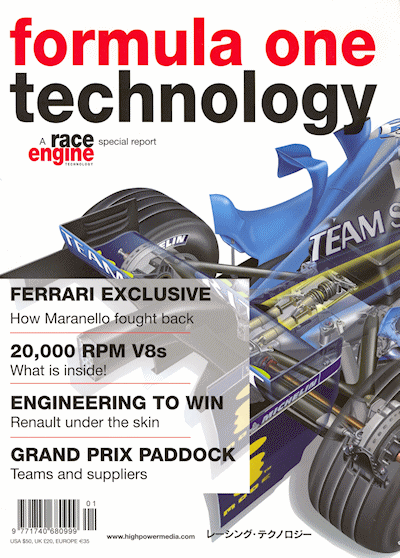
F1 Race Technology, Volume 1
FEATURES:
1. Introduction - A series of mini-features describing various aspects of 2006 / 2007 F1 technology, including (a) new regulations and their impact, (b) the effects of the second-order crankshaft vibrations caused by a V8 engine with a flat-plane crank, (c) "seamless" gearshift systems, (d) suspension mass dampers, (e) flexible wings, (e) scuttle fins, and (f) wheel shrouds.
2. Life at the Limit - A detailed discussion of why the cars are no slower after the loss of nearly 200 HP resulting from the mandated engine shrinkage from 3.0 liters to 2.4 liters.
3. Recapturing Greatness - An in-depth examination of the development of the dominant Renault F1 car: engine, transmission, packaging, vibration, aero, etc.
4. V8 Heat - An in-depth examination of the innards of the 20,000 RPM F1 V8 engine.
5. Back On Form - A study of the development of the resurgent Ferrari F1 car: engine, chassis, suspension, rotary dampers, dynamics, development.
6. Bridgestone For All - A discussion of the implications of a single tire supplier for all F1 teams.
SPECIAL 2012 REPORT: 24-Hour Race Technology, Volume 6
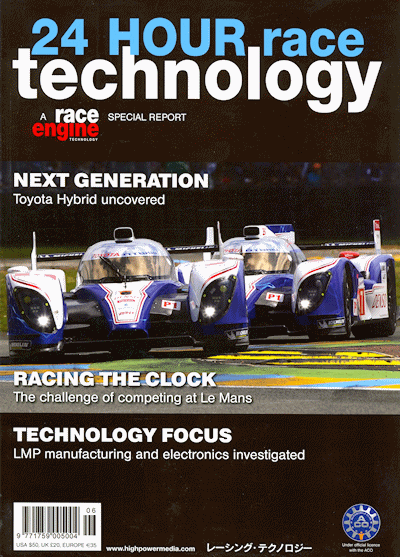
24-Hour Race Technology, Volume 6
(click for larger image)
FEATURES:
1.GRID - The latest news from pit lane, including: Audi Hybrids triumph at Le Mans; Hydrogen fuel set for debut in 2013; New 2014 fuel efficiency regulations; Mazda Diesel LM-P2 engine, and more.
2. PROFILE: DeltaWing - Lawrence Butcher details how the most unconventional and controversial car at Le Mans 2012 was designed and developed, including concept, development, dynamics, aero, chassis, engine and gearbox.
3. INSIGHT: Racing for 24 Hours - Anne Proffit reports on what the Vingt-Quatre Heures du Mans is really like for team drivers, engineers, mechanics, and other team members.
4. FOCUS: Electrics and Electronics - David Cooper reports on some key developments in electrical and electronic systems for Prototype endurance race cars, including batteries, connectors, headlights and cooling, sensors, and various digital control units (a long way from when the "Prince of Darkness" was a key supplier!).
5. PROFILE: Toyota TS-030 - Lawrence Butcher reports on Toyota's 2012 return to the top rung of Le Mans racing, with a high-tech hybrid, including concept, development, chassis, powertrain, aero, and more.
6. FOCUS: Design and Manu-facturing - David Cooper investigates the design, development and manufacturing technologies and techniques that go into the building of a successful Le Mans Prototype racer, including 3D-CAD, FEA, carbon fiber, metalics, aero design and evaluation, rapid prototyping, and more.
7. PROFILE: Aston Martin Vantage GTE - Lawrence Butcher reports on the development work that went into Aston Martin's revamped GT racer.
8. TECHNICAL REVIEW, 2012 - The Le Mans 24 Hours endurance race creates a need for some very specific and demanding technologies. Anne Proffit reports on some of the key entrants in that group.
SPECIAL 2011 REPORT: 24-Hour Race Technology, Volume 5
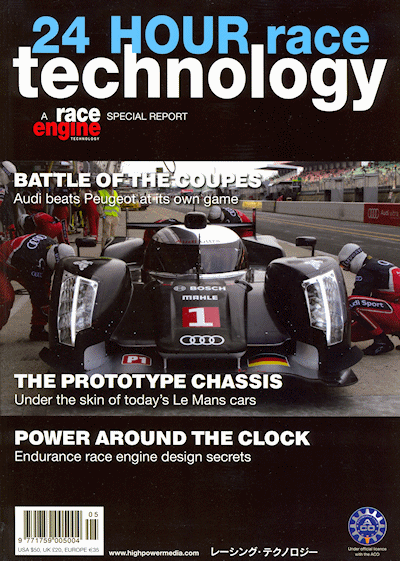
24-Hour Race Technology, Volume 5
FEATURES:
1.GRID - Nine informative synopsis articles, including: (a) the maiden-win for the new Audi-R18-TDI; (b) Porsche hybrid returns to LM-P1; (c) Aston Martin's problems in the 2011 race; (d) the radical Dallara "Delta-Wing" chassis; (e) the growth of Rapid Prototyping; (f) Mazda's return to LM-P2; (g) HPD's clever gearshift lockout.
2. DOSSIER: Audi LM-P1 - Anne Proffit reports on how Audi's preparations for this year's LM-P1 race paid huge dividends in a win, despite in-race difficulties.
3. INSIGHT: Le Mans Engines - Oliver Allan reports on the guiding factors and tradeoff parameters for the design of a successful petrol racer engine for LM-P1.
4. FOCUS: Transmissions - Lawrence Butcher provides a detailed technical insight into how manufacturers have made huge leaps in improving the durability and functionality of transmission systems for Le Mans racing.
5. DOSSIER: Hope Racing LM-P1 Hybrid - Anne Proffit provides a fascinating report on "what it takes" to prove that a flywheel-based hybrid can compete at the LM-P1 level.
6. FOCUS: Prototype Chassis - Lawrence Butcher finds out what are the proper ingredients needed to create a top-flight sportscar chassis in the 21st century.
7. DOSSIER: Robertson Racing Ford GT - Anne Proffit delves into the details of how a family-owned team won a podium finish at Le Mans with the venerable Ford GT.
8. Le Mans 2011 - A review of this year's Le Mans engines plus the directory of suppliers.
9. PS: Audi and LM-GTP - Ian Bamsey's remarkable memory provides one of his enlightening history lessons, recalling the late 1990's and the evolution of the Audi R8C.
SPECIAL 2010 REPORT: 24-Hour Race Technology, Volume 4
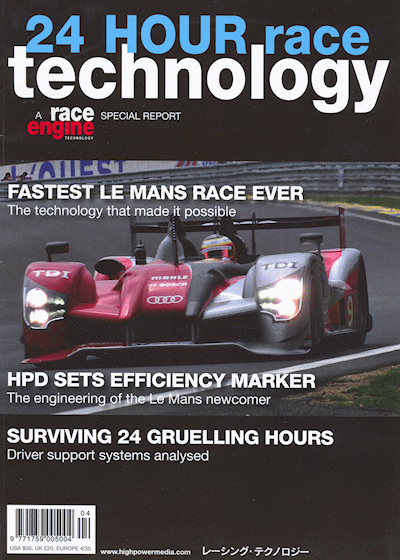
24-Hour Race Technology, Volume 4
FEATURES:
1. GRID - Six informative synopsis articles covering: (a) KERS at Le Mans; (b) Problems with tearoff windscreens; (c) new LM-P1 & P2 powerplant evolution; (d) Juggling restrictors to level LM-P1 power; (e) the radical new coupe from Wirth Research; (f) advances in LED-based lighting.
2. ANALYSIS: The Balance of Power - Audi vs. Peugeot: A detailed comparison of the advances in each LM car and the closeness of this year's competition.
3. INSIGHT: Engine Durability - Wayne Ward provides a detailed look at how some of the major players approach race engine durability.
4. PROFILE: Zytek LM-P1 - A fascinating look at the features of the Zytek LM-P1 car and how the team was able to snag F1 world champion Nigel Mansell to drive it.
5. INSIGHT: Suspension - A detailed investigation into the current technology which provides the vital link between the chassis and the four contact patches.
6. PROFILE: Highcroft LM-P2 - Anne Proffit reports on how Highcroft Racing fared in its first LM-P2 outing: car, strategy and personnel details).
7. INSIGHT: 24-Hour Driver Support Systems - Anne Proffit reports on the support systems that drivers need to survive a race that runs twice around the clock.
8. PROFILE: Corvette GT-2 - Anne Proffit reports on how Corvette Racing fared in its first foray into 24-hour GT-2 racing at Le Mans.
9. INSIGHT: Transmissions - John Coxon provides a fascinating look inside Le Mans transmission technology, discussing the requirements of 24-hour racing and how they are met.
10. PADDOCK - Who's Who in the world of 24-hour race engineering, including the manufacturers and the private competitors.
11. PS: Toyota 20 Years Ago - Ian Bamsey provides yet another fascinating look back into 24-hour racing history.
SPECIAL 2009 REPORT: 24-Hour Race Technology, Volume 3
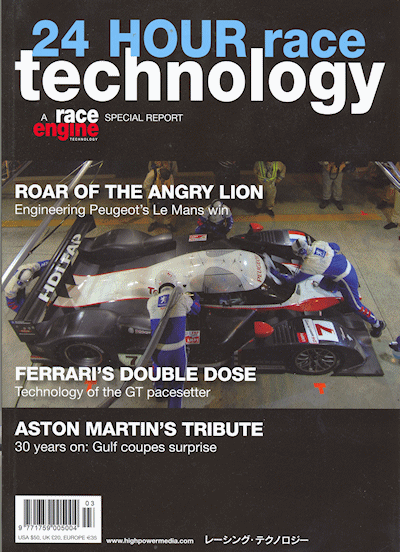
24-Hour Race Technology, Volume 3
FEATURES:
1. GRID - Five informative synopsis articles covering: (a) the return of the coupes to Le Mans prototype racing; (b) Porsche's excellent fuel efficiency; (c) Corvette's new direct fuel injection technology; (d) the prospect of new / returning competitors to the GT2 class; (e) the double win for the Porsche 4.0 liter boxer at Daytona and Nurburgring.
2. INSIGHT: Peugeot; Victorious at Last - Details of how Peugeot's persistence and ingenuity paid off in the winning of the 77th Le Mans classic.
4. SPECIAL INVESTIGATION: Petrol vs. Diesel - Battle for equality: how diesel power has enjoyed four years of growth and supremacy and how ACO has tried to level the playing field.
5. PROFILE: Audi R15 - After an encouraging start to the 2009 season, great things were expected from the new R15. Ian Bamsey takes an in-depth look at the R15's development path.
6. TECHNO-TOPIC: Flying like the Wind - Yoshi Suzuka (design team engineer) describes the design challenges faced by engineers of the Nissan R35 GTR.
7. INSIGHT: Aston Martin - For the first time ever, Aston Maartin was trepresented in three classes at Le Mans. Anne Proffit reports on the development of these cars and their achievements in this year's race.
8. INSIGHT: Ferrari F430GT - The Ferrari F430GT filled nine of the top ten places in the GT2 class this year. Anne Proffit looks at the success of class winner Risi Competizione in this highly competitive corner of the grid.
9. INSIGHT: Honda Acura & BMW - Honda's rise to prominence in the ALMS series caught most of the opposition napping. Anne Proffit delves into Honda's somewhat unconventional car and how they achieved their meteoric rise.
10. Le Mans Paddock - A magnificent tabulation of details about all the 2009 Le Mans participants: Prototype engine manufacturers, Prototype constructors, and GT marques. It includes, for each car, engine and chassis ID, Wednesday and Thursday qualifying times, grid position, finishing position and laps run.
11. PS: - Ian Bamsey discusses the importance of the nose diffuser.
SPECIAL 2008 REPORT: 24-Hour Race Technology, Volume 2
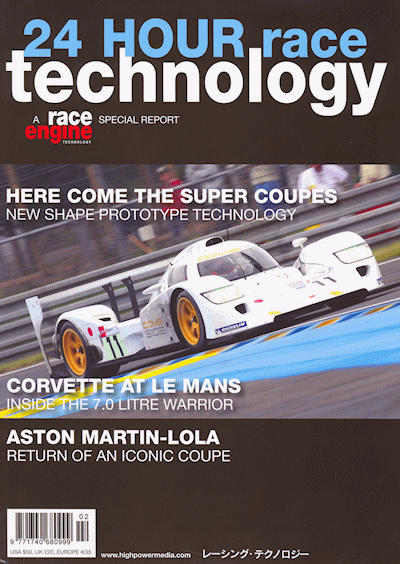
24-Hour Race Technology, Volume 2
FEATURES:
1. Grid - Eight informative synopsis articles covering: (a) LM-P1 Audi Diesel v. Peugeot Diesel; (b) LM-P1 Diesel engines v. Gasoline engines; (c) the LM-P2 1st & 2nd place Porsche RS Spyders; (d) the LM-P2 Judd-V8-powered Lola B08; (e) the LM-P1 Hayashi 4-liter turbocharged V8 engine; (f) details on the LM-GT2 Spyker Cars; (g) a keen table listing the ACO regs for each class; (h) the evolution of the Lola Le Mans cars.
2. INSIGHT: Peugeot 908 - A detailed investigation into the development of the '07 and '08 pole-winning Peugeot 908 diesel and the technology embodied in the car. ALSO includes an excellent sidebar article on the details of diesel race engines.
3. INSIGHT: Corvette Close Up - An overview of the technology in the C6.R Corvette as raced in GT-1.
4. INSIGHT: Lola Aston Martin, The Surprise of 2008 - An investigation into details on the fastest gasoline-powered car this year: the Aston-Martin powered Charouz-owned Lola.
5. INSIGHT: The New Coupes - A discussion of the relative merits of the closed-roof prototypes vs. the traditional open-cockpit style.
6. INSIGHT: Porsche 997 RSR , Flying but Not WInning - Details on the two fastest GT-2 cars: the Porsche 911 GT3-RSR (997).
7. Le Mans Paddock - A magnificent tabulation of details about all the 2008 Le Mans participants: Prototype engine manufacturers, Prototype constructors, and GT marques. It includes, for each car, engine and chassis ID, Wednesday and Thursday qualifying times, grid position, finishing position and laps run.
8. PS: - Ian Bamsey provides a look back at the Sauber Mercedes Le Mans legend.
SPECIAL 2007 REPORT: 24-Hour Race Technology, Volume 1
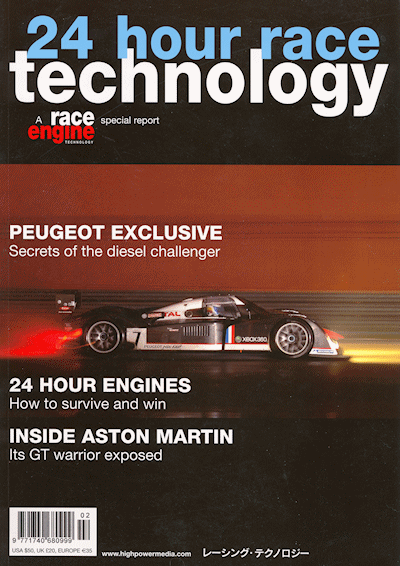
24-Hour Race Technology, Volume 1
FEATURES:
1. Introduction - A series of mini-features describing various aspects of engine rules, aero, the four major gearboxes, and clutches.
2. Life At The Limit - A well-known designer of proven LeMans Prototypes discusses the performance potential of LMP1 and LMP2 cars, including the implications of gasoline vs. diesel, various inlet-air restrictors, cooling drag, overturning moment, and other subjects.
3. Starship Enterprise - Details about the Peugeot 908 diesel challenger to the LeMans-winning Audi diesel: engine layout, components and control systems, turbocharger system, emissions control, transmission, chassis, suspension, brakes.
4. Compression or Spark? - A discussion with John Judd about the pros and cons of diesel vs. gasoline in the LeMans context.
5. Gasoline Alley - An in-depth investigation of the newest LeMans gasoline engine: The 3.6 liter V8 turbo from Advanced Engine Research (AER).
6. Porsche vs. Ferrari - A mini-feature on the details of the Porsche LM-GT2 car.
7. Best of British - Details about the Aston Martin DBR9 LeMans car: GT1 regulations, DBR9 engine, suspension, aerodynamics.
SPECIAL 2013 REPORT: RALLY Race Technology, Volume 1
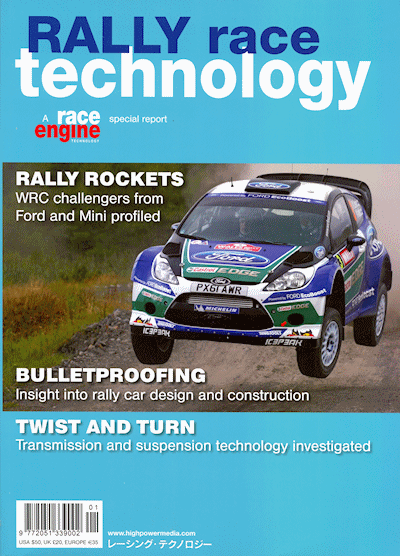
RALLY Race Technology, Volume 1
FEATURES:
1.GRID - A collection of interesting short articles including: Technical descriptions of Peugeot's new, dedicated rally cars (the 208-R2 and the 208-R5); The Lotus Exige GT Rally Car; The return of VW and Hyundai to WRC competition; New WRC regulations; The resurgence of Rallycross; An explanation of the FIA's Group-R regulations; and lots more.
2. PROFILE: Ford Fiesta RS WRC - Martin Sharp presents an in-depth look at the Fiesta WRC, a truly-effective World Rally Car, designed and run by M-Sport. This article includes coverage of the direct injection technology, cylinder head development issues, gearbox and driveline technology.
3. FOCUS: Rally Transmissions - Lawrence Butcher examines the demands facing rally transmission & Differential design engineers, covering regulations, materials, gear manufacture, construction, packaging, and operational challenges.
4. INSIGHT: Rally Car Design - Lawrence Butcher examines the unique requirements for a competitive rally car and how they translate into the design of the components and systems, including subjects such as operational dynamics, packaging, safety, aero and others.
5. FOCUS: Suspension - Martin Sharp discusses the wide and varied functions that rally suspensions must perform well, and how component designs (tires, springs, dampers, anti-roll bars, and active suspension components) have developed to improve those performance factors.
6. PROFILE: Mini-John Cooper Works WRC - Martin Sharp explains how, despite a prolonged gestation period, the MJCW World Rally Car has proven to be an effective competitor.
7. TECHNICAL REVIEW - Lawrence Butcher presents a round-up of some of the latest technology developments to hit the rally stages, including coatings, clutches, brakes, and body-shell developments.
SPECIAL 2012 REPORT: DRAG RACE Technology, Volume 3
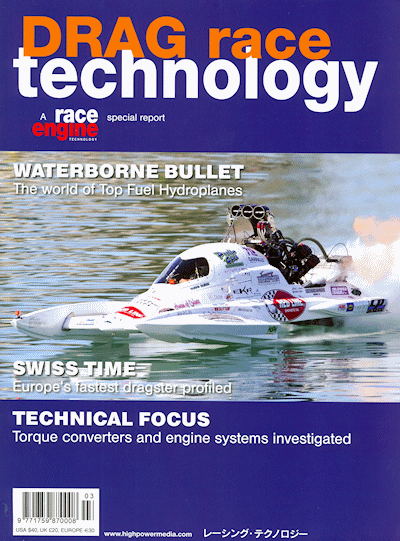
DRAG RACE Technology, Volume 3
Published in November, 2012, this issue discusses Funny Car developments, Chassis and Transmission Technology, European Pro-Mod, and lots more.
FEATURES:
1. GRID - A series of mini-features describing various new developments, including: The developing firestorm over the safety "shroud" ban; a new Mustang for Pro Stock; the advances in electric dragsters, and more.
2. PROFILE: Don Schumacher's NHRA Funny Car - Driver Matt Hagen and crew chief Tommy DeLago recently made history when they became thew first team to make a 1000 foot competition pass in less than 4 seconds. This article reports on the technology needed to accomplish that feat.
3. INSIGHT: Top Fuel Engines - Oliver Allan (F1, Indy, LeMans race engine designer formerly at Ilmor, Mercedes HPE, AER) looks at the development of the top fuel dragster engine from an F1 engineering perspective, discussing air and fuel consumption, unbelievable peak cylinder pressures, rotating and reciprocating component challenges and more.
4. PROFILE: Euro Pro Mod Racing - Daniel Cooper finds out what went into making Andy Robinson's Studebaker so successful on the European drag circuit
5. FOCUS: Chassis - Lawrence Butcher takes an in-depth look at the design and construction challenges facing a Funny Car chassis builder, including tuning the chassis torsional stiffness, weight distribution, materials, tuning of the wheelie-bar, chassis construction, safety issues, and more.
6. PROFILE: Fish / Tonglet Racing Pro-Stock Bike - Anne Proffit discovers how one Louisiana family won the Pro Stock motorcycle competition, and produced the youngest champion ever.
7. FOCUS: Transmissions - A fascinating look into the innovative and savvy transmission technology deployed in some of the most popular drag racing classes, including top fuel slip clutches, manual gearboxes, automatics, torque converter technology, shafts and couplings, and the critical role of data logging.
8. REVIEW: Technology Development - Lawrence Butcher discusses aspects of certain drag engine hardware that has seen notable improvement in recent years, including pistons, wrist pins, rings, springs, rods, billet blocks, head work and more.
SPECIAL 2011 REPORT: DRAG RACE Technology, Volume 2
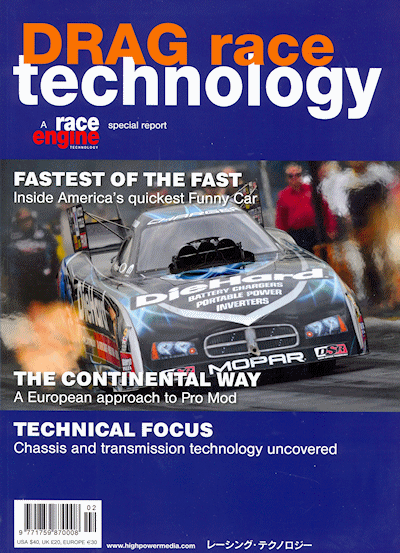
DRAG RACE Technology, Volume 2
Published in December, 2011, this issue discusses Funny Car developments, Chassis and Transmission Technology, European Pro-Mod, and lots more.
FEATURES:
1. GRID - A series of mini-features describing various new developments, including: The developing firestorm over the safety "shroud" ban; a new Mustang for Pro Stock; the advances in electric dragsters, and more.
2. PROFILE: Don Schumacher's NHRA Funny Car - Driver Matt Hagen and crew chief Tommy DeLago recently made history when they became thew first team to make a 1000 foot competition pass in less than 4 seconds. This article reports on the technology needed to accomplish that feat.
3. INSIGHT: Top Fuel Engines - Oliver Allan (F1, Indy, LeMans race engine designer formerly at Ilmor, Mercedes HPE, AER) looks at the development of the top fuel dragster engine from an F1 engineering perspective, discussing air and fuel consumption, unbelievable peak cylinder pressures, rotating and reciprocating component challenges and more.
4. PROFILE: Euro Pro Mod Racing - Daniel Cooper finds out what went into making Andy Robinson's Studebaker so successful on the European drag circuit
5. FOCUS: Chassis - Lawrence Butcher takes an in-depth look at the design and construction challenges facing a Funny Car chassis builder, including tuning the chassis torsional stiffness, weight distribution, materials, tuning of the wheelie-bar, chassis construction, safety issues, and more.
6. PROFILE: Fish / Tonglet Racing Pro-Stock Bike - Anne Proffit discovers how one Louisiana family won the Pro Stock motorcycle competition, and produced the youngest champion ever.
7. FOCUS: Transmissions - A fascinating look into the innovative and savvy transmission technology deployed in some of the most popular drag racing classes, including top fuel slip clutches, manual gearboxes, automatics, torque converter technology, shafts and couplings, and the critical role of data logging.
8. REVIEW: Technology Development - Lawrence Butcher discusses aspects of certain drag engine hardware that has seen notable improvement in recent years, including pistons, wrist pins, rings, springs, rods, billet blocks, head work and more.
SPECIAL 2010 REPORT: DRAG RACE Technology, Volume 1
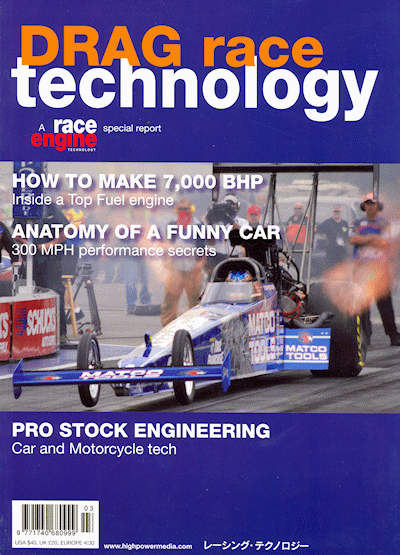
DRAG RACE Technology, Volume 1
FEATURES:
1. GRID: - A series of mini-features describing various new developments, including: the heavy focus on better driver safety, triggered by the recent loss of two Funny Car drivers; the evolution of air-shifters on manual gearboxes; advances in fuel delivery systems; a traction meter for quantifying track grip, and more.
2. INSIGHT: Top Fuel Engines - Wayne Scraba investigates the engineering needed to create components to withstand the enormous destructive forces inside drag racing's most powerful (7000-8000 HP) engines, including blocks, cranks, rods, pistons & pins, heads and manifolds, valve train, oil, fuel and ignoition systems, superchargers, and more.
3. PROFILE: Pro Stock Motorcycle - Steve Tartaglia, head of Don Schumacher Racing's Pro Stock Motorcycle team, reveals his technical and managerial secrets.
4. INSIGHT: Funny Car Chassis - Shorter tracks and new regulations have inspired improvements in Funny Car chassis design and construction, tire dersign, safety equipment and driver protection. Wayne Scraba reports on some of these new developments.
5. INSIGHT: Crew Chief Secrets - Anne Proffit delves into what it takes to be a top crew chief in the premier categories of NHRA drag racing, and discovers that there are as many opinions as there are top tuners.
6. INSIGHT: Pro Stock Cars - In this highly-regulated category of drag cars, the competitive edge is often measurable in thousandths of a second. Wayne Scraba describes the painstaking attention required for each individual component on these custom-built vehicles, and the interactions with other pieces and systems in the car.
7. FOCUS: Sportsman Categories - The heavily-restricted racecars in Stock, Super Stock and Comp classes have considerably less publicity and much smaller purses, yet they attract the largest numbers of competitors. Wayne Scraba looks into the technology and challenges in these classes.
8. PROFILE: Running a Top Fuel Car - With the help of DPM driver Antron Brown and crew chief Lee Beard, Anne Proffit reports on her first hand observations of the preparation and tuning needed to get a top fuel car into competitive trim for the 2008 US Nationals.
9. GLOBAL REPORT: Drag Racing Worldwide - A look at the rapid worldwide expansion of drag racing, at the spearhead of the worldwide explosion of interest in motorsport, including the UK, Australia, Norway, Sweden, Finland, Poland, Italy, Malta and South Africa.
